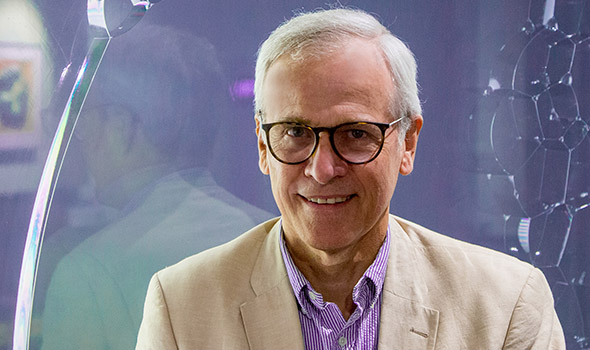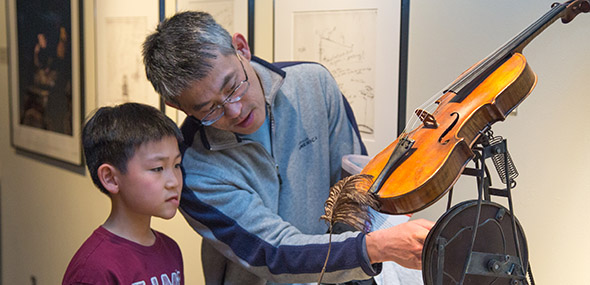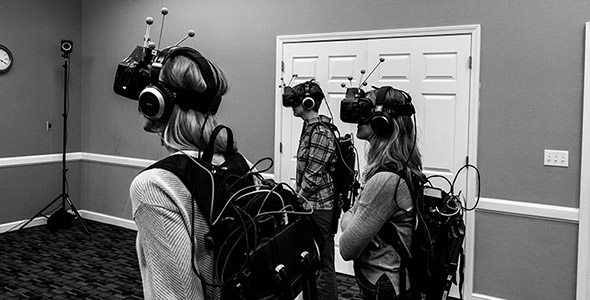PUBLIC ENGAGEMENT
John Durant plans a new era for the MIT Museum

“The new museum will be an experimental place, committed to the idea that the MIT Museum can operate along the same principles as the Institute as a whole. We want to try new ideas, test them, and report our findings.”
—John Durant, Director of the MIT Museum, and faculty member, MIT School of Humanities, Arts, and Social Sciences
In the 12 years since John Durant took the helm at the MIT Museum, he has opened up the ground floor to gain street-level visibility, launched the Cambridge Science Festival, and grown attendance from around 50,000 to nearly 150,000 visitors a year.
Now, as he makes plans for a new, purpose-built museum in MIT's burgeoning gateway location in Kendall Square, Durant says he is looking forward to offering the public deeper insights into the research under way at MIT.
"This is the big opportunity for the MIT Museum to be something like what MIT and the public deserve," says Durant, who is both the Mark R. Epstein Director of the MIT Museum and a member of the faculty in MIT's School of Humanities, Arts, and Social Sciences (SHASS). “In our new location, we can anchor and mediate MIT's relationship with the wider community.”
Engaging with the public is more critical than ever today, Durant says, because the value of science and of evidence-based reasoning has been called into question by some segments of society. “We have suddenly plunged into a situation — briefly, I hope — where it's fashionable in some groups to believe that facts can be as you'd like them to be,” he says.
Yet, understanding science is necessary to make informed decisions on issues both private and public — from individual health care to national defense, says Durant, who received his Ph.D. in the history and philosophy of science. “There are a multitude of ways in which science is relevant to our daily lives whether people know it or not,” he says. “Much of public policy has scientific aspects and dimensions.”

Photo: Lisa Abitol, courtesy MIT Museum
“Creative expression and the critical examination of ideas in their social and historical contexts are essential to the work of any museum, and particularly to the work of the MIT Museum."
The human world at the core of MIT's mission
Durant's faculty home is in the SHASS-based Program in Science, Technology, and Society (STS) whose humanities and social science researchers explore science, technology, and medicine to understand the human challenges at the core of MIT's mission. STS is one of several programs that make SHASS the hub of the Institute’s major initiatives focused on furthering public engagement with science and technology. In the Graduate Program of Science Writing, the SHASS faculty train some of the world's finest science journalists. In the Knight Science Journalism Fellowship program (KSJ), the School provides outstanding mid-career science journalists and communicators a year of discovery at MIT. Undark Magazine, KSJ's digital publication, explores ideas and endeavors at the intersection of science with political, cultural, and economic realities.
"Creative expression and the critical examination of ideas in their social and historical contexts are essential to the work of any museum, and particularly to the work of the MIT Museum. This is why we are always looking for ways to incorporate the work of MIT faculty in the arts, humanities, and social sciences. A great example is our forthcoming special exhibition, 'The Enemy' (opening October 2017).
This exhibition emerges from collaboration between photojournalist Ben Khelifa and Fox Harrell, an MIT faculty member with a joint appointment in Comparative Media Studies and the Computer Science and Artificial Intelligence Laboratory. 'The Enemy' uses virtual reality technology to stretch visitors' senses as well as their emotional and moral imaginations, and we hope that it will foster more understanding in one of the places where it is most needed — in situations of human conflict.”

Photo: Lenny Martinez, MIT Center for Art, Science, and Technology
A forthcoming MIT Museum exhibition, The Enemy, results from a collaboration between photojournalist Ben Khelifa and Fox Harrell, an MIT Professor of Digital Media and AI. The project uses virtual reality "to stretch visitors senses as well as their moral imaginations," aiming to foster more understanding in situations involving human conflict.
Wider conversations
Durant notes that the MIT Museum is also a place where visitors can get an inside look at the work that takes place at a world-class research institute. “People can understand a bit about MIT by engaging with the ideas and theories that MIT folks engage with,” he says, in research that ranges broadly across many fields.
“MIT's humanistic disciplines — history, philosophy, cultural studies — and the social sciences all bring distinctive, analytic voices to bear on questions to do with science and its place in the wider society," says Durant. "They allow us to have wider conversations. They provide context, illuminating the broader implications of scientific research."
The contributions of artists, composers, and playwrights are equally important. “You get radically different conversations when you bring the sensibilities of accomplished artists to the table,” Durant observes. “If you want to understand Einstein's Theory of Relativity, you can take a class or read a textbook. Or, you could see a production of ‘Einstein's Dreams’ [a play based on the novel of the same name by SHASS Professor Alan Lightman] … This play takes you into the world of Einstein's thought experience — as only an imaginative writer can do.”
Einstein's Theory of Relativity can be difficult to understand, but making such material accessible to all is one of the key goals of the MIT Museum, Durant says. “We're trying to find ways to engage people in science that's legendarily hard — like quantum mechanics,” he says. “We aim to make even conceptually tough science accessible to more people.”
An experimental space
For example, this past February, the MIT Museum hosted an evening of live theater and conversation based around a current research project in quantum mechanics that is co-led by Professor David Kaiser, a physicist and historian of science. Durant says he expects the museum will find even more ways to bring scientists and other MIT researchers together with the public in the Kendall Square location, where it will have 57,000+ square feet of galleries, classrooms, and state-of-the-art program and performance spaces. The new museum is expected to open toward the end of 2020.
“The new museum will be an experimental place,” says Durant, who is committed to the idea that the MIT Museum can operate along the same principles as the Institute as a whole. “We want to practice what we preach as a research university: Try new ideas, test them, and report our findings.”
Suggested links
About the MIT Museum planned for Kendall Square
Program in Science, Technology, and Society
MIT School of Humanities, Arts, and Social Sciences
NYT's story: Meeting "the Other" Face to Face
The Enemy, exhibit at the MIT Museum
Story prepared by MIT SHASS Communications
Editorial and Design Director: Emily Hiestand
Senior Writer: Kathryn O'Neill
Photographs:
Of John Durant: Jon Sachs, SHASS Communications
Of "The Enemy": Lenny Martinez, courtesy of MIT CAST
Of the violin work: Lisa Abitol, MIT Museum